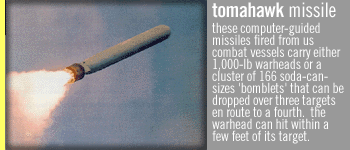



 The Tomahawk cruise missile (the BGM-109) is a 20-foot-long weapon costing
$1.3 million. A booster rocket shoots the missile off a ship or submarine.
Then the small turbofan engine takes over and the missile jets toward land,
directed by its "inertial-guidance system" which uses sensors and gyroscopes
to measure acceleration and changes in direction. Once the missile crosses the shoreline, a more precise guidance method, TERCOM, takes over.
The Tomahawk cruise missile (the BGM-109) is a 20-foot-long weapon costing
$1.3 million. A booster rocket shoots the missile off a ship or submarine.
Then the small turbofan engine takes over and the missile jets toward land,
directed by its "inertial-guidance system" which uses sensors and gyroscopes
to measure acceleration and changes in direction. Once the missile crosses the shoreline, a more precise guidance method, TERCOM, takes over.
TERCOM scans the landscape at set checkpoints, taking altitude readings and
comparing them to map data in its computer memory. The missile moves at about
550 miles per hour, and can make twists and turns like a radar-evading fighter
plane all the while skimming over the land at 100 feet to 300 feet.
After covering up to 1,500 miles the Tomahawk closes in on its target and a
third guidance system then takes over: DSMAC (Digital Scene Matching Area
Correlator). DSMAC snaps a picture of the target area and compares that data
to a version in its memory. The computer then gives the wings and tail fins a final adjustment and takes the warhead to its target.
The Tomahawk and the Tomahawk Antiship Missile (TASM) are fitted on Iowa-class
battleships; cruisers of the Virginia, Long Beach, and Ticonderoga classes;
and destroyers of the Arleigh Burke and Spruance classes.


Desert Storm was the first combat test of the cruise missile system. It also
marked the first coordinated Tomahawk and manned-aircraft strike in history.
Within the first few minutes of Operation Desert Storm, Tomahawk missiles
launched from the battleships Missouri and Wisconsin struck with accuracy at
Iraqi command centers, and radar installations .
In the war, Tomahawks were used to destroy surface-to-air missile sites,
command and control centers, electrical power facilities and were credited
with the destruction of Iraq's presidential palace.


"During the war, 297 Tomahawks were fired, of which 282 began their mission
successfully (9 failed to leave the tube and 6 fell into the water after
leaving the tube). At least 2 (and possibly as many as 6) were shot down,
most or all of them in a single quickly arranged stream attack (the missiles
had to fly a single mission profile most of the way to their target)." From:
"Desert Victory - The War for Kuwait" by Norman Friedman Naval Institute Press
1991.
From "Gulf War Air Power Survey Summary Report" by Thomas A. Keaney and
Eliot A. Cohen:
U.S. Forces used three platforms during the Gulf War that were in the
stealth/low-observability category: the F-117 stealth fighter and two
long-range cruise missiles, the Tomahawk Land Attack Missile (TLAM) and the
Conventional Air-Launched Cruise Missile (CALCM)......The F-117, which flew only two percent of the total attack sorties, struck nearly forty percente of the strategic targets and remained the centerpiece of the strategic air campaign for the entire war.
Low observability made possible direct strikes at the heart of the Iraqi air
defense system at the very outset of the war. In the past, air forces fought
through elaborate defenses and accepted losses on their way to the target or
rolled those defenses back. In the Gulf War, the Coalition could strike Iraqi air defenses immediately, and they never recovered from these initial, stunning blows. With the combination of stealth and accuracy possessed by the F-117 and cruise missiles, these two platforms carried out all attacks against downtown Baghdad; the F-117 operated at night and the TLAMs during the day. Given the American sensitivity to casualties--our own and Iraqi civilians--they were ideal weapon systems for attacking targets in the heart of a heavily defended, heavily populated city. Moreover, the F-117 had a psychological utility that was probably shared only by the B-52. Both were aircraft of a kind that only a super-power could have, and both could deliver destruction with no advanced warning--small wonder, then, that both figured prominently in psychological operations pamphlets that were showered upon Iraqi troops.
On the other hand, the F-117 and long-range cruise missiles also had
limitations: both were less flexible and considerably more expensive than
most conventional systems. The F-117, a subsonic, light bomber, had to
operate at night to maximize stealthiness, and nearly nineteen percent of the strikes attempted by F-117s were adversely affected by weather (misses or no drops). While not as sensitive to weather conditions as the F-117, cruise missiles had a smaller payload, required a lengthy targeting process, and could not be retargeted after launch. Even without the flexibiltiy of other aircraft, however, these platforms were able to set the terms for air operations over Iraq and to bring the reality of the war home to the residents of Baghdad.
FRONTLINE interview with Bernard Trainor

home · oral history · war stories · weapons · maps · chronology
tapes & transcripts
FRONTLINE · wgbh · pbs online
web site copyright WGBH educational foundation
 |